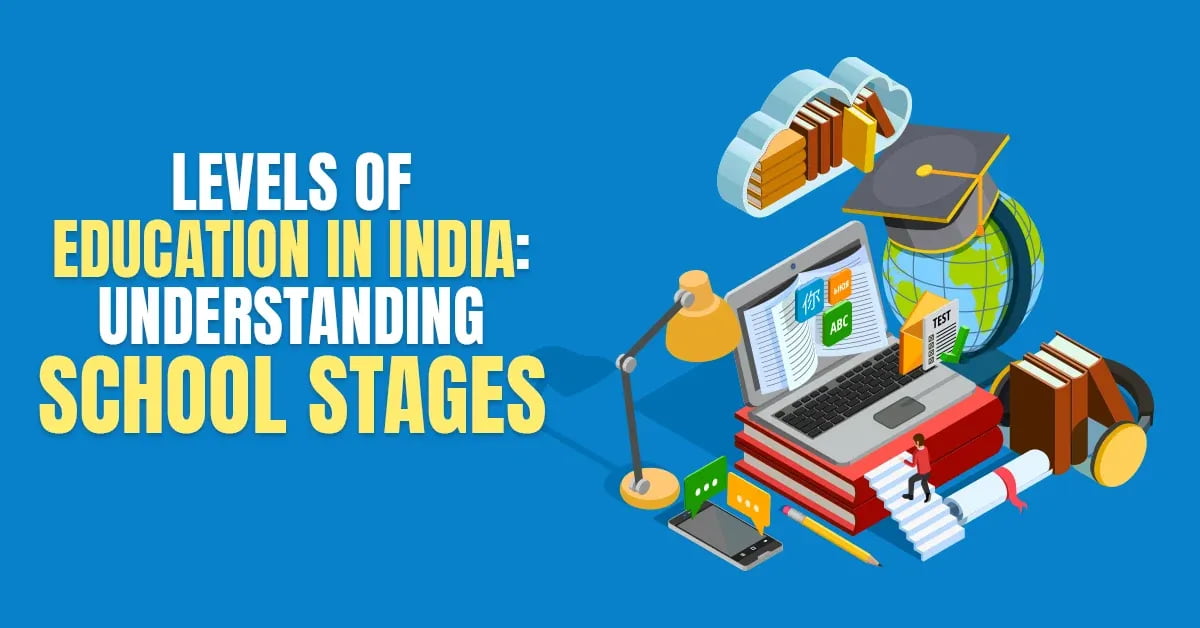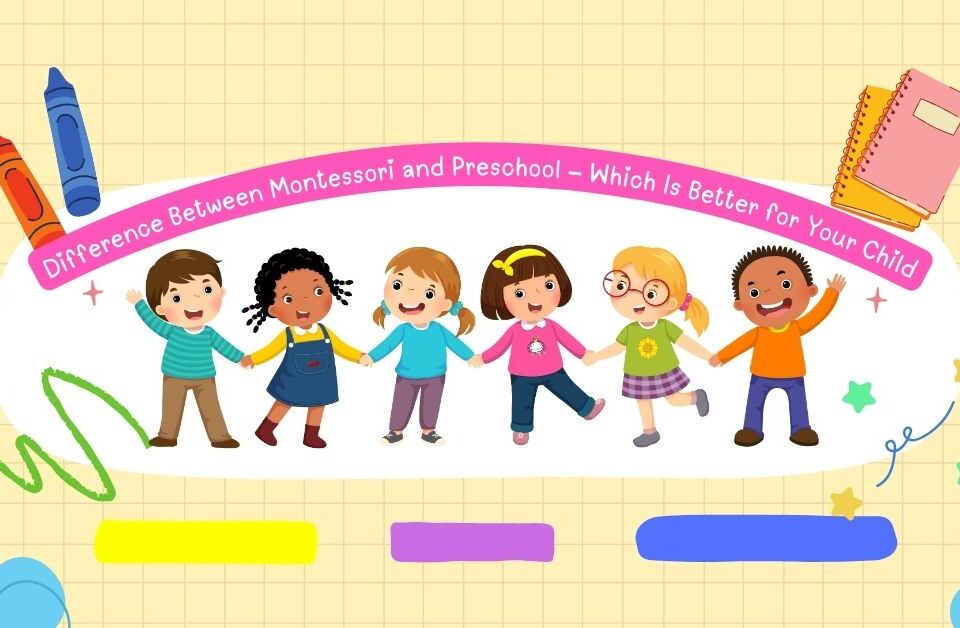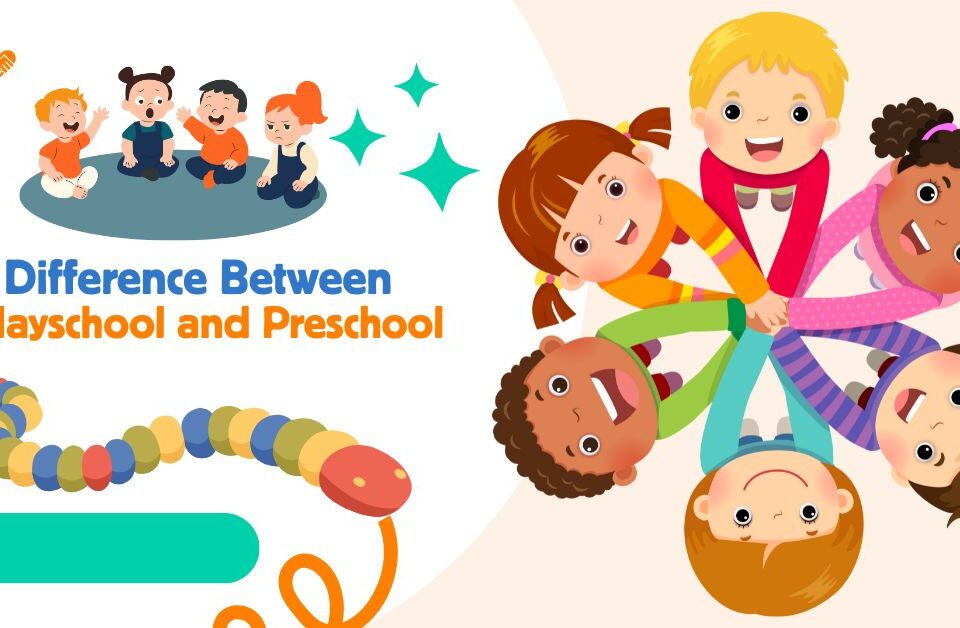
Montessori vs Preschool: Key Differences Explained
June 18, 2025
10 Benefits of Private Schools: Advantages of Private Education
June 29, 2025Levels of Education in India Today: Understanding the Stages of School Education
Introduction to the Indian Education System
Once you have enrolled your child in the right preschool, it’s natural to think that your job is done for now. However, you must be aware and informed about what lies ahead in their educational journey.
That’s because India’s education system is quite vast and very structured. It successfully guides a child from their foundational years of education to advanced studies.
Hence, if you want to ensure that your child is on the right path to success, you must plan ahead.
The Indian education system follows a well-defined framework, which is traditionally known as the 10+2 system in India.
However, the implementation of the New Education Policy (NEP) 2020 ensures that this structure is changed to offer more flexibility, inclusivity, and skill orientation.
What is the 10+2 Education System in India? Structure & Importance
The traditional 10+2 education system of India includes 10 years of general education and 2 additional years of higher secondary schooling. This is the standard curriculum of most schools in India.
The main central boards of education in the country, like CBSE and ICSE, as well as State education boards in India, follow this structure with minor modifications.
Every level of education is designed to ensure that all students experience age-appropriate learning and progress steadily and consistently.
Levels or Stages of Education in India Today: From Preschool to Postgraduate
Each and every stage of education is significant for a child. So, let’s get educated about the various levels of education in India today!
Stage 1: Pre Primary Education in India (Ages 3 to 6)
This is the stage where your child’s formal education begins. It’s typically suitable for children aged between 3 and 6 years.
This level of education can be further divided into play schools in India (ages 2.5 to 3.5 years), Nursery and Lower Kindergarten, and Upper Kindergarten.
It is the birthright of every kid to receive early childhood education in India. During this stage, they are encouraged to be curious, develop social skills, and improve their sensory abilities.
Also Read: Differences Between Pre Primary and Primary Schools: Which Stage Is Crucial for Your Child?
Stage 2: Primary or Elementary Education in India (Classes 1 to 4/5, Ages 6 to 10)
After the pre-primary stage comes primary education in India. It’s recommended for kids aged between 6 and 10 years.
Don’t get confused because in some parts of the country, it is also referred to as elementary education in India.
This is when formal subjects are introduced to your child. They learn basic language, mathematics, general knowledge, and environmental studies.
All government schools in India offer this level of education. In such schools, the fees may be lower and, hence, accessible to families who cannot afford an expensive education for their children.
On the other hand, the teaching methods of primary education may differ slightly in private schools in India. At the end, all schools focus on building basic academic and emotional skills during this stage.
Also Read: Montessori vs Traditional Preschool: Which One is Right for Your Child?
Stage 3: Middle School Education in India (Upper Primary, Classes 5/6 to 8)
Next comes upper primary education in India, which is advised for children aged 11 to 13.
At this level, the subjects become a little more complex and diverse. It includes science, social studies, and a second or third language.
During classes 5 to 8 in India, students are encouraged to develop independent thinking, problem-solving abilities, and interpersonal skills!
Some states in India, such as Assam, Goa, Gujarat, etc., offer middle school education from classes 5 to 7. On the other hand, states like Arunachal Pradesh, Haryana, Madhya Pradesh, etc., provide the same for classes 6 to 8.
Stage 4: Secondary Education in India (High School, Classes 9 & 10)
At this stage, students enter secondary school in India. It’s far more complicated and difficult than their previous classes.
Moreover, the Class 10 board exams play a very significant role in shaping their academic and career decisions. Thus, more emphasis is placed on academics and scores during this level.
Their higher secondary education depends on their Class 10 result. They are allowed to specialise in a stream of their choice only if their results are favourable.
Many refer to this level as high school in India. Students are usually around 14 to 16 years old at this stage.
Stage 5: Higher Secondary or Senior Secondary Education in India (Classes 11 & 12)
Finally, students step into the stage of senior secondary education in India. They are allowed to choose from the science, commerce, or arts streams in India. However, this choice should be based on their interests and future goals.
Classes 11 and 12 in India also fall under the higher secondary school system. It prepares students for university, competitive exams, or vocational careers. Hence, their academic performance is of immense importance.
While most schools offer this level of education, some colleges may also accept students for classes 11 and 12.
Stage 6: Undergraduate Education in India (After Class 12 or Bachelor’s Degrees)
Once they’re done with school, students finally move to the stage of undergraduate education in India. This includes enrolling in courses such as B.A., B.Sc., B.Com.
Some students also opt for professional programs like B.Tech and MBBS. These courses can go on for 4 to 5 years.
It’s known as a bachelor’s degree in India, which usually spans 3 to 4 years. In this stage, the rules are slightly different and loose.
Most colleges in India may have a dress code, but not a uniform. Moreover, you may have a different routine every day based on your course.
Stage 7: Postgraduate Education in India (Master’s Degrees & Beyond)
Postgraduate education in India includes a master’s degree. You can get one by enrolling in courses like M.A., M.Sc., M.Com., etc., that generally last for 2 years.
A master’s degree in India is usually pursued by students who want to probe deeper into academic research. The degree will give them appropriate resources and recognition. Thus, this stage is one of the highest levels of education in India.
Once you have successfully completed this degree, you can add the prefix of “Doctor” to your name. After this degree, you can continue to do research or teach in colleges and universities.
Stage 8: Adult Education Programs in India
However, your education does not stop at the postgraduate level. India believes in lifelong learning. Hence, the country offers adult education in India with the help of the National Literacy Mission and continuing education in India programs.
Illiteracy is a major issue in the country. However, these initiatives strive to improve adult literacy in India, especially among underserved communities. This enables wider access to education with equal participation.
Stage 9: Distance Learning & Open Schooling in India (NIOS, Online Classes)
It’s not always possible for every student to leave their homes and study. That’s why India offers flexible learning options like distance education in India.
Institutions like the National Institute of Open Schooling (NIOS) and various open universities in India offer remote learning. This allows students to learn from home, sit for exams, and successfully secure a degree.
Moreover, after the COVID-19 pandemic, online education in India has observed a surge in its popularity! It ensures that students of all ages and backgrounds have access to equal educational opportunities.
Stage 10: Homeschooling in India
Finally, homeschooling in India is also quite popular. However, it may be a little unconventional. Parents who choose this alternative education in India have the freedom to decide the pace and learning of their children.
While this mode of education is not formally integrated, homeschooling is completely legal.
Many progressive families find the structured curriculum of schools to be unappealing. Hence, they choose homeschooling as a viable alternative.
New Education Policy (NEP 2020): How It’s Reshaping Indian Schooling
The New Education Policy in India (NEP 2020) has introduced a new framework that has transformed the traditional schooling system of India.
NEP introduced the 5+3+3+4 structure, which replaced the earlier 10+2 system in India. According to the new policy, the different stages are as follows:
- 5 years of Foundational Stage: This includes 3 years of preschool (nursery, LKG, UKG), class 1, and class 2
- 3 Years of Preparatory Stage: This level spans from classes 3 to 5
- 3 Years of Middle Stage: This stage includes classes 6 to 8
- 4 Years of Secondary Stage: This includes classes 9 to 12
This new system puts a strong focus on hands-on learning, concept understanding, and less mindless memorising of educational materials.
Instead, it encourages teaching methods that are more flexible, creative, and suited to how children actually learn.
But that’s not all. NEP 2020 also brings other important changes, such as:
- Teaching in the mother tongue or regional language (where possible) until Class 5
- A shift towards skill-based learning and vocational subjects
- More freedom for students to choose subjects based on their interests
- A new approach to assessments that looks beyond marks and exams
Thus, NEP 2020 is designed to help students become confident, capable, and creative thinkers right from the beginning of their learning journey!
However, the 10+2 model isn’t officially abolished yet. Boards like CBSE still use ‘Class 10’ and ‘Class 12’ exams in their traditional structure.
Also Read: What Is The Right Age For Play School Admission?
Final Overview: Understanding India’s Education Stages for Students & Parents
Thus, when parents remain aware of the education stages in India, it helps them plan their child’s academic growth and development.
Moreover, when you have reforms like NEP 2020, you must remain updated at all times to ensure that your child gets to experience the latest and the best.
This, in turn, guarantees an enriching educational journey and a successful career in the future.
Kickstart Your Child’s Education with JBM Smart Start Preschool
Give your child a smart start with JBM Smart Start! We follow the latest NEP 2020 guidelines to ensure your child receives a supportive and holistic development. Our curriculum blends play-based learning, experiential methods, and values-led teaching! You are welcome to explore our preschool programs today and give your child a smart start for tomorrow!
Also Read: Choosing the Best Pre-Primary School in Greater Noida: A Complete Parent’s Guide
FAQs: Levels and Stages of India’s Education System
Q1: What is the current structure of school education in India?
Ans: The new structure under NEP 2020 is 5+3+3+4. It aims to do away with the old 10+2 format. However, many schools still follow the traditional format.
Q2: Is homeschooling allowed in India?
Ans: Yes, homeschooling is legal in India. However, it is not yet formally regulated. Parents must ensure that they provide a balanced curriculum for their child for steady progress and growth.
Q3: What are the main differences between CBSE and ICSE boards?
Ans: CBSE focuses on a national-level curriculum that is helpful for students who will be sitting for competitive exams. On the other hand, ICSE offers a broader and more detailed syllabus. Its curriculum lays equal emphasis on languages, arts, and science.
Q4: Are open schooling and distance education equally valid?
Ans: Yes. Institutions like NIOS and open universities are recognised by the Indian government. They offer valid certifications for distance education and open schooling!




